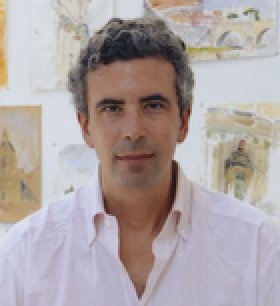Columbia College | Columbia University in the City of New York
Take Five with Adam Van Doren ’84, GSAPP’89

What were you like when you arrived at Columbia?
I arrived as a freshman from Evanston, Ill., where I had gone to high school and middle school (I was born in Boston). My early aspirations were to attend art school and I had considered the Rhode Island School of Design, but I decided, in the end, it was much better to pursue a liberal arts degree. I had known about Columbia because my family has had a long association with the University: My grandfather Mark Van Doren GSAS 1921 taught English and Humanities for more than 40 years, as did my great-uncle Carl and my uncle Charles GSAS’59. My father, John Van Doren GSAS’52, got a Ph.D. there. It was inspiring to be on the same campus they had been. I also thought NYC would be an exciting place to explore art.
What do you remember about your first-year living situation?
I was assigned to Livingston Hall (now Wallach) and I had a small room, but it was a single overlooking the campus, which I liked. Second semester I moved to the newly built East Campus dorm, where I lived in a suite with three roommates. It seemed quite luxurious at the time, and I enjoyed — again — having my own room. It was also nice to be living in a quiet corner of the campus, away from the fray.
What Core class or experience do you most remember, and why?
The Lit Hum class I had with Professor Barbara Crehan GSAS’80. She put so much effort into the discussions and always asked penetrating questions in our seminar sections. I still hear her voice when I think of The Iliad and The Odyssey. She was a shining example of a dedicated faculty member who took the Core very seriously and believed in its value to achieve a large understanding of the world. I have kept her in mind as a model during my teaching years at Yale.
Did you have a favorite spot on campus, and what did you like about it?
I became an architecture major, and enjoyed Avery Library to study. It was fun to take a break from my studying and pick out from the shelves a random large folio of a particular artist’s or architect’s work. I also liked walking around and looking at the models of famous buildings that were on display. And, if I really wanted to procrastinate further, there was the café on the lower level. I also used to like sneaking up with friends to the roof of Pupin, where you could see a great view of the city at night.
What, if anything, about your College experience would you do over?
I suppose I would have gotten more involved in Spec. I had done cartoons for my high school paper, and had thought about drawing for the Columbia paper, but there was already a fabulous cartoonist at the time named R.J. Matson ’85, who I didn’t think I could compete with. In general, I found my time was hard to spare, given my heavy load of homework — especially in the architecture studio — and my hours as a DJ for WKCR for the bluegrass music show “Moonshine,” which I did on Saturday afternoons. My interest in folk music came from my playing the banjo, which I performed on occasion with classmate Robbie Fulks ’84 at Postcrypt Coffeehouse and at the Furnald Folk Fest.

